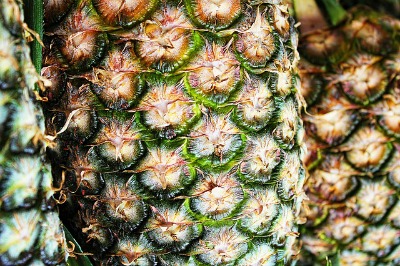Simple fruits are those fruits in the angiosperms that develop from a single ovary of one flower.
This ovary may be either simple or compound. Unit fruits or true fruits are those that represent the individual components of an aggregate or multiple fruits.
Various types of fruits are here listed and described.
However, there are fruits having characteristics that do not perfectly fit into the specific description of any fruit type for which such terms as drupe-like, berry-like, and nut-like are used.

Types of Simple Fruits and Unit Fruits
1. Achene – a dry, indehiscent, very small one-seeded fruit derived from a simple ovary, the seed attached to the pericarp only at one point (e.g. true fruit of strawberry, sunflower, and other members of the family Compositae or Asteraceae).
2. Anthocarp – a dry, indehiscent, one-seeded small fruit (achene) enclosed by a fused perianth or receptacle, as in the four o’clock family Nyctaginaceae.
3. Berry – a fleshy, indehiscent simple fruit derived from a simple or compound ovary, having one too many seeds, with a soft and fleshy pericarp or most of it. (e.g. tomato, guava, grape, lanzones, eggplant, individual fruit of pineapple).
In some literature, the avocado and banana are described as baccate or berry-like fruits. Two specialized berry fruit types are pepo and hesperidium.
4. Capsule – a dry, usually dehiscent fruit that develops from a compound ovary, splitting open in multiple sutures into several seed-bearing sections or carpels, e.g. cotton, durian, kapok, castor bean, okra.
5. Caryopsis or grain – a dry, indehiscent, one-seeded fruit of the grass family that develops from a simple ovary, with a pericarp that is fused to the seed coat and not separable from it, e.g. rice, corn kernel, wheat, millet, sorghum.
6. Drupe or stone – a fleshy indehiscent simple fruit that develops from a simple ovary, with the layers of the pericarp distinctly separated.
The endocarp which encloses the seed is hard and woody or stone-like.
In most fruits, the mesocarp is fleshy when ripe (e.g. mango).
The coconut is considered a dry drupe, with a mesocarp (the husk) that is fibrous when mature.
7. Follicle – a dry, dehiscent fruit derived from a simple ovary, usually splitting open at one side when mature. (e.g. magnolia (Magnolia), peony (Paeonia), and milkweed (Asclepias).
8. Hesperidium – a special type of berry with a leathery rind and is segmented, typical of the citrus family.
9. Legume or Pod – a dry, usually dehiscent, few- to many-seeded fruit of leguminous plants (family Leguminosae or Fabaceae) derived from a simple ovary, splitting open at both sides when mature, as in bean, pea, mungbean, peanut, and soybean.
Loment is a specialized legume.
Loment – a special type of legume that breaks apart into indehiscent, seed-bearing segments, as in Desmodium.
10. Nut – a dry, indehiscent, usually one-seeded fruit derived from a simple ovary, with a pericarp that ranges in texture from leathery to hard and woody (e.g. oak, chestnut).
The pericarp may be entirely or partly surrounded by an involucre consisting of fused sepals, bracts, and bracteoles.
11. Pepo – a special type of berry with a hard, thick rind and is not segmented, the ovary partially or entirely enclosed by the receptacle, typical of the family Cucurbitaceae (e.g. squash, cucumber, muskmelon, watermelon, pumpkin).
Some cucurbits produce a dehiscent capsule and not a pepo.
12. Pome – an accessory fruit in which the seed-bearing ovary or core is surrounded by a fleshy tissue called hypanthium or floral tube, which is not a part of the pericarp.
The hypanthium develops from the fused bases of perianth segments. e.g. apple (Malus), pear (Pyrus), quince, Cydonia, and Chaenomeles).
13. Samara – a dry, indehiscent one-seeded small fruit derived from a simple ovary, with one or more wing-like appendages, e.g. maple.
14. Schizocarp – a dry, indehiscent fruit of the carrot or parsley family (Umbelliferae or Apiaceae) derived from a compound ovary; the seed-bearing carpels break apart but remain close.
15. Silicle and Silique – dry, dehiscent, elongated simple fruits derived from a compound ovary, usually with many seeds such as in the members of the mustard family Brassicaceae or Cruciferae.
The two fused carpels split apart when mature, leaving a thin membrane in the middle to which seeds are attached.
A silicle is broader than long while a silique is longer than broad.
16. Utricle – a dry, indehiscent, thin-walled one-seeded small fruit similar to an achene but with a loose pericarp and is like a small bladder, characteristic of the duckweed family (Lemnaceae).
